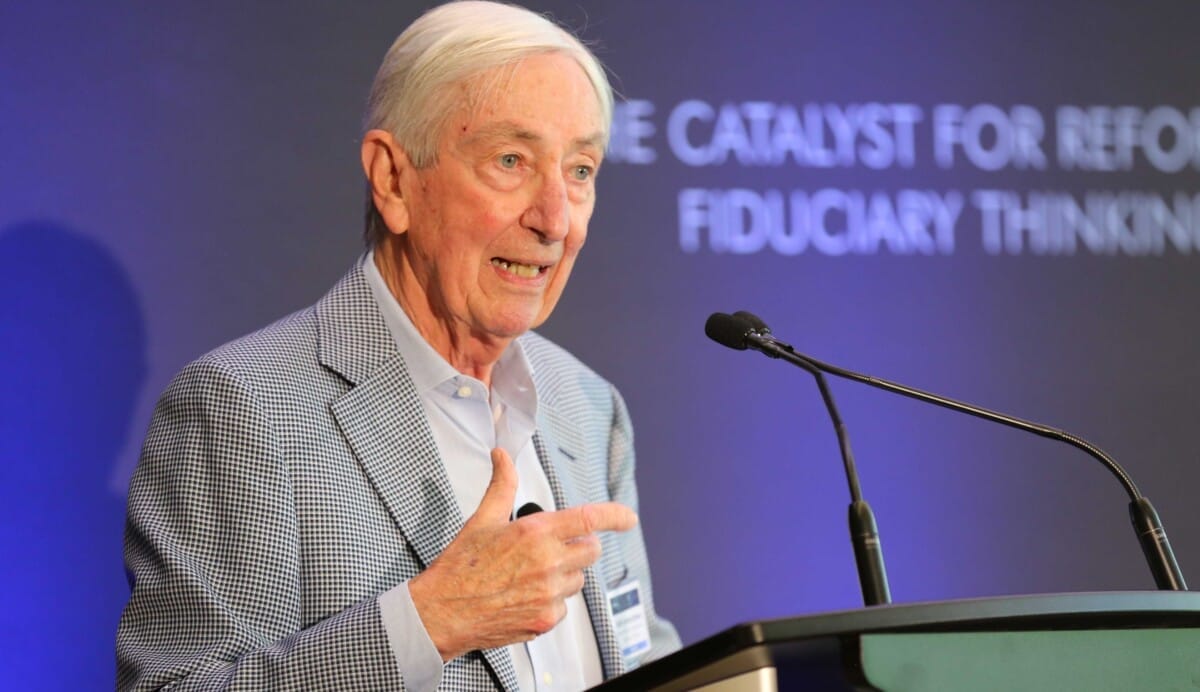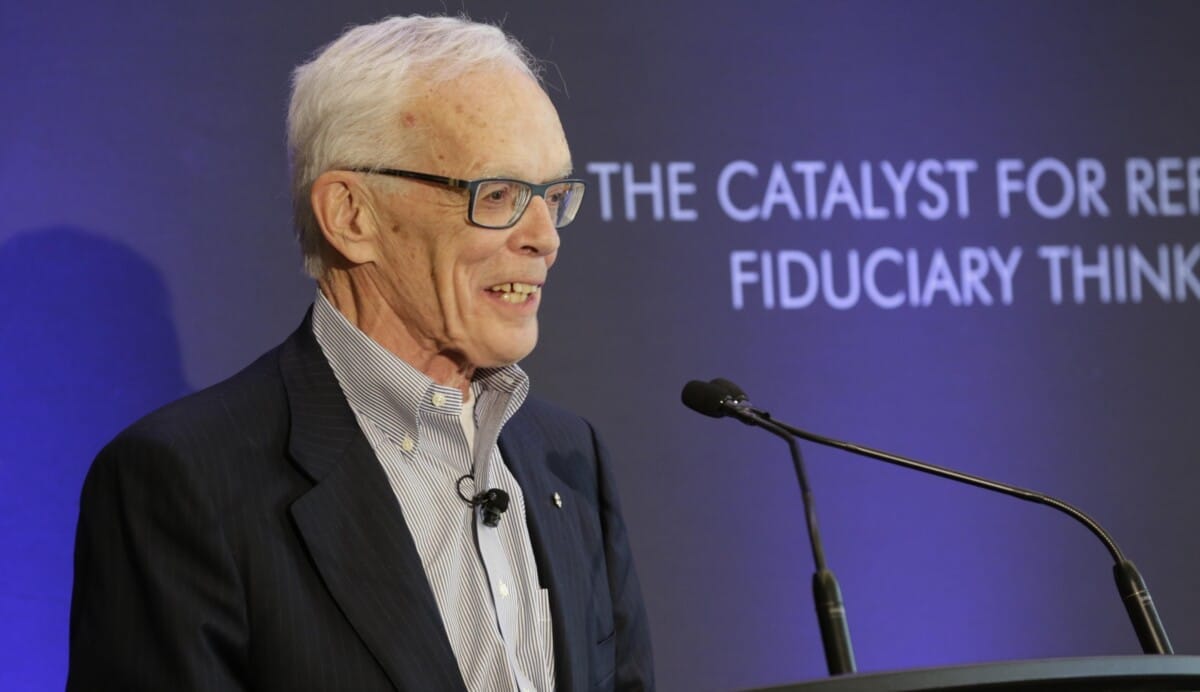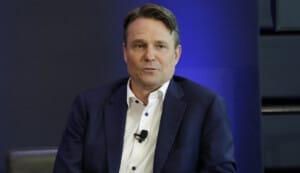The Canadian pension fund market has grown to around $4 trillion in value and is dominated by eight major players – the so-called Maple 8. But that hasn’t stopped a high degree of innovative and flexible business models, all built on the considerable groundwork undertaken by those who went before them.
The Top1000funds.com Fiduciary Investors Symposium in Toronto heard that the endgame for any fund in terms of its structure and processes and its path to get there depends on the starting point.
Barbara Zvan joined the University Pension Plan (UPP) as chief executive in 2020 when “literally, at this point, they had a plan text, and they didn’t really have regulatory approval yet, and there was, I kid you not, not a stapler to be found”.
“There was nothing,” she said.
“I had 24 great years at Ontario Teachers, apparently working with a bunch of legends and lots of great colleagues. I was very comfortable with what $100 billion or $200 billion looks like. UPP is $12 billion – I’m missing a zero. It’s a lot harder to manage $12 billion than $120 billion because everything costs 10 times more when you look at it as an MER. So I called 18 friends.
“I started saying, so what do you do? And what do you have? What have you been able to do? I also called CEM [Benchmarking]… and used some of the product data. And you saw a real differentiation: after $10 billion they started doing some privates and things.”
Zvan said early decisions included what aspects of investment management should be internalised, what should be external, and how should external managers be assessed.
“At the top of the house in terms of research, knowing that I will have a complex portfolio of liabilities and also from the study of talking to 18 peers, not a lot of that group did asset liability work or risk analysis,” she said.
“We made an explicit investment to do that internally, ourselves.”
Zvan said that while she was at Ontario Teachers, she oversaw the establishment of three different risk systems, and given the volume of data the fund held, the last one took six years.
At UPP she is “putting in Aladdin in a year”, she said.
“There are so many more tools that you can leverage today.”
Logical and progressive
Zvan said it was critical to build systems and processes in a logical and progressive way and not try to do everything at once.
“Have you ever watched a crab walk across a beach? Look at the legs, they don’t all move at the same pace, but it gets to a direction,” she said.
“So really when building UPP, that is the balance between what do I need to build now, which controls first, what depends on what we’re doing, and we’re taking that approach.”
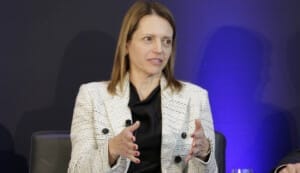
Zvan said there were five principal enablers in building UPP into an effective pension organisation from a standing start. She said the first was staffing, and “making sure that talent is incentivised, it’s innovative and it can come with ingenious solutions, and there’s a good culture”.
The second was appropriate systems and controls, so that if a university wanted to conduct due diligence on UPP before committing staff pensions to it, “we wanted excellent marks”.
“They’re giving us their money, the members are giving us the responsibility for their pensions, we want to make sure we have the right controls,” Zvan said.
Zvan said UPP spent considerable time on the third enabler, namely developing the right structure, including governance. At the outset “not only there was no organisation, I can tell you there was not even a delegation to management, there was not one committee mandate, there was no board operating guidelines”.
“We had to build all that framework of how this board would work,” she said.
Compensation was also critical as the fourth enabler, and Zvan said UPP wanted to ensure “we had the right incentives in place”. She said the organisation hired around 200 people and “for the vast majority of them, we had no incentive program yet”.
“I gave [them] a letter, some people can attest, [saying] there is a salary, this is your first bonus, trust me,” she said.
“That was that was the extent of it.”
And finally, UPP was able to leverage technology as an enabler. Zvan said technology had advanced in leaps and bounds since the early 90s.
“One reason why we could get up so much quicker is, one, we had the playbook; but two, we leveraged technology completely,” she said.
“We were in the middle of COVID, we did cloud software as a serious service. We don’t code one line of code today, we just move data around and we leverage and try to be good buyers in that area.”
The $113 billion Investment Management Corporation of Ontario was formed in 2016 and chief executive Bert Clark told the symposium that “I don’t think anyone can understate the work that that Claude [Lamoureux] and the early legends, pioneers, of the Canadian model did to establish the importance of good governance”, the benefits of which funds today continue to reap.
“I still think that’s the bedrock of what we do,” Clark said.
“It gives us operational freedom; ideally, lack of political interference – well, there’s always that perpetual risk [and] we’ve seen it recently.”
New avenues open
Clark said developments in the industry mean the newer funds have some new avenues open to them that weren’t as readily available to older funds established many decades ago.
One such theme is cost efficiency, Clark said.
For some older funds, cost efficiency was captured by internalising investment management and building out large teams.
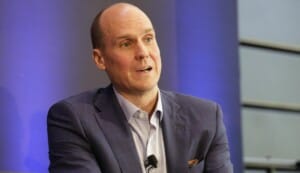
“But when [they] were internalising, Brookfield was $20 billion; today, Brookfield is a $1 trillion,” Clark says.
“There’s nothing alternative today about private assets, they’re half our portfolio and probably half of others’.
“For us, there’s just a very different calculus today about how we get at cost efficiency. We actually made a very deliberate decision not to build big internal teams, but to still target cost efficiency through partnerships.”
Clark noted that “it makes no sense for us to try and compete with [asset managers like] Apollo or Antares or Aries”.
“What we need to be doing is figuring out how to partner with them on the most efficient terms because they have origination and value add capabilities that we just cannot replicate,” he said.
“That’s awesome. We have we have a different size, frankly, than a CPP, or a [Ontario] Teachers, even today. I think the spirit of cost efficiency is something that that is still very much alive and well.”
Clark echoed Zvan’s comments about advances in technology and the options and flexibility it presents to funds today.
“When I arrived at IMCO, I had no email system,” Clark said.
“I used to get [told] ‘we promise we’ll pay you’ and they paid me in checks. Literally, I remember I got a check and had to go to the [bank]. I hadn’t done that in a long time.
“And in five years we put in an email system, in less than five years actually, an HRIS system a risk system, a total portfolio system, a custodian. In fact, we’re on our second risk system, and so to me there are there are massive advantages we have in starting today and massive cost advantages that we can access through actually outsourcing, as opposed to internalisation.”
Clark says cost efficiency arises “by having operational latitude to make the right decisions between internal, external, paying people the right level or paying external managers”.
Investment and operational innovation
Clark says that from the outset, Canadian funds have demonstrated high levels of investment and operational innovation
“They were…doing swaps, they were investing in private assets. They were some of the early bidders on infrastructure when only a couple of bidders showed up to buy things like [Highway] 407, where you’d now have a lineup to buy it, or AltaLink.
“There’s probably nothing that’s ever totally new. But I think that spirit of innovation is still something you find in all the Canadian funds.”
Clark says any organisation also needs to understand and operate within its own limitations.
“[Thinking] you’re going to outsmart everyone, as you know, is not a good strategy,” he said.
“We’re very disciplined about saying we don’t have to do everything, and let’s make sure that if we’re trying to do something, if we’re trying to generate that very elusive net value add we have some credible basis for doing that. So [the big things are] the right asset mix, adequate liquidity, avoiding the big bet and only compete where you have an advantage.”
Even though the Healthcare of Ontario Pension Plan (HOOPP) was established in 1960, chief investment officer Michael Wissell said things are being looked at today “perhaps a little bit differently than [they] might have been looked at…in the early 2000s”, including, for example, managing liquidity.

“The entire industry has been tenaciously focused on liquidity all the way along, as an industry we’re realising [that] there was a mentality years ago that ‘cash is trash’, it was out of the endowment model which was [to] be fully invested [at] long-term maximum risk all the time, and over time that would harvest the greatest returns,” Wissell said.
Wissell says that in recent years “you’ve seen a little bit more of an adaptive world, where maintaining some firepower, so to speak, or cash or leverage availability or what have you [and] basically being liquid and being able to take up tomorrow’s opportunity set, actually sowing those seeds in those environments are where you really can meet your returns.”
‘Fewer people than years ago’
A continued focus on operational efficiency and containing costs and enabled by relatively recent advances in technology and processes, and evolving relationships with external asset managers, means that today “you probably can manifest a team that runs with fewer people than maybe we thought years ago”.
“And actually, that has more than just the benefits of keeping the economics controllable,” Wissell said.
“You have to remember every profligate dollar you spend doesn’t compound for the next 50 or 75 years. A profligate dollar spent today doesn’t compound and, as Einstein said, the most powerful force in the universe is compounding.
“But in addition to that, you can create other exogenous problems…if you let your teams grow beyond the ability for them to engage in meaningful work.
“This industry is in evolution. We all benefit by the learnings of the of the funds that came before us [and by thinking about] liquidity and cost containment and how big do you want these teams to be. Are you trying to compete with GPs, or are you trying to leverage GPs? These are elements of the industry that are truly being rethought and reimagined as we go forward.”
Alberta Investment Management Corporation (AIMCo), established in 2008, manages pension funds on behalf of a range of individual clients “and that makes us a little more complicated in certain ways”, its chief investment officer Marlene Puffer, who took up her current role only last year, told the Symposium.
“We don’t have one pool of capital that we can easily manipulate,” Puffer said.
“We can’t easily layer on derivatives and allocate back out to the clients. We can, but it’s not easy.
“As a result, we have pools and we have to deal with some pools we are able to have as open pools for our clients; some have to be closed pools and reissued in different vintages. It’s a pretty complex platform.”
Puffer said she personally had not worked at Ontario Teachers before joining AIMCo, but many individuals there had, including her immediate predecessors, and they “set up AIMCo’s systems and approaches in the image of Teachers, and there’s lots of great things about that”.

“But some things that are make things challenging, because there’s it started out as a focus on total fund,” she said.
“We actually have 17 clients and 32 pools of capital and we actually need to pay close attention to each one of those and make sure we’re delivering what each client actually needs.
“We’re really rebuilding, in some ways, some of that approach and how we tackle our asset management and the systems related to it.”
That means the operational demands of the organisation are quite distinctive, Puffer said.
“We need a team on client relationship management, we need a team that is paying attention, not just at the total portfolio or total fund level, but we need to actually pay attention to each of these clients individually.”
Strategy is everything
Puffer said that “strategy has to drive everything” as the organisation grows and develops.
“The strategy and how we’re internally versus externally managed, all of those things that [other panellists] have articulated so well, are so key,” she said.
“And yet, the starting point matters.”
Puffer said AIMCo started with a significant internally managed direct investment portfolio, which was global and diversified.
“It already is there; I can’t shut that down [and] I don’t want to shut that down,” she said.
But at the same time, the organisation is rethinking and becoming more strategic about the relationships it has with external managers to harness growth and scale, and “getting smarter” about creating “a real strategic partnership model, not just for infrastructure, but for every one of our asset classes, and importantly, across our asset classes.
Puffer said large asset managers “have an incredible global platform, and we want to be a part of that.”
“But we also don’t want to be beholden to them entirely,” she said.
“A model of co-investment alongside direct investing is at the heart of it. And then you back out of that, what does the staffing have to look like?”
Puffer said AIMCo is establishing global offices and expanding from its home base of Edmonton into Calgary, Toronto, New York, London and Singapore, and “part of the reason for that is to be able to hire people with the right expertise and the right level of experience”.
“It’s all driven by strategy,” Puffer said.
“And a big pillar of our strategy today is expanding our diversification globally.
“So it all interconnects. You can’t talk staffing without talking about your business model and strategy.”
